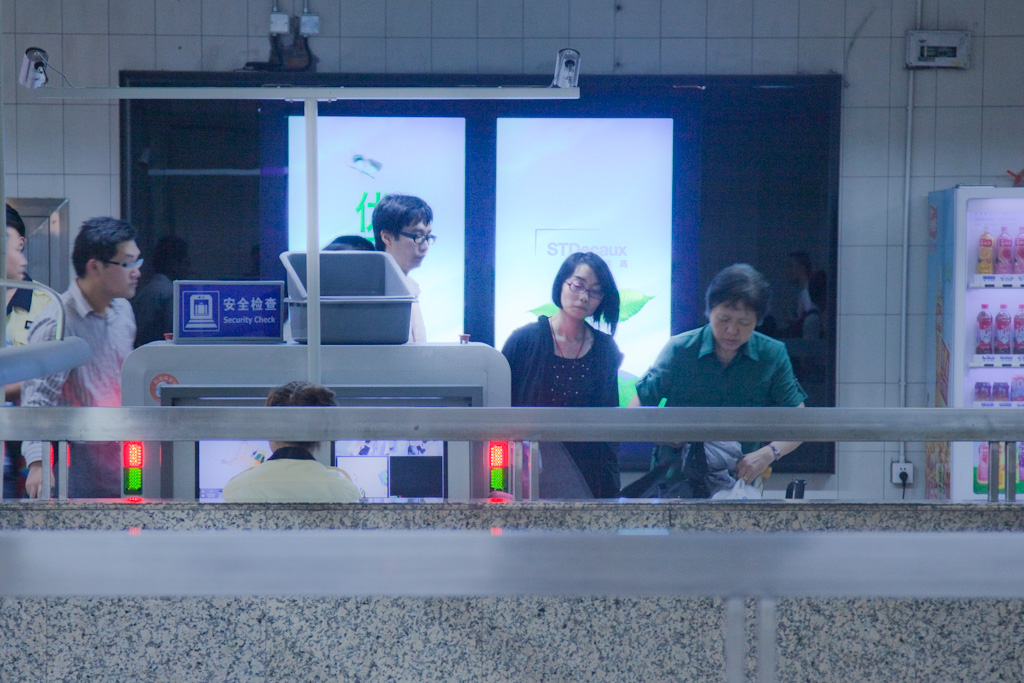Start here.
As anyone whose spent a day tailing consumers in Shanghai will tell you: a Chinese shopper and her bags are not easily parted – the perceived risks are simply too great. Which is why the introduction of security scanners at every Shanghai metro station is so compelling – the process of scanning bags for all sorts of suspiciousness for a short time at least drives a physical wedge between the carrier and what is carried. Given the sheer volume of Shanghainese passing through these security checkpoints every day, does this break from existing behavioural norms suggest a shift in carrying (and by extension interaction) norms, or does it merely serve to reinforce existing practices?
Why is this an interesting topic? Well, for example in many stores there’s a strong correlation between having hands free and purchasing behaviour – an unladen shopper is in a position to linger, touch, try which increases the likelihood of a sale. And if you want to take a step back and consider the broader context of how we interact with our urban environments read the link above and then this by Dan Hill.
Few things are more obvious for Chinese high street consumers than the need to keep their carried objects safe from harm: the twin demands of high risk of theft/low likelihood of recovery combined with a perceived lack of clean surfaces on which to place things mean that on shopping expeditions the shopper tries to maintain tactile and visual contact with bags at all times. It manifests itself in a range of ways – from where a bags are placed when not in use if indeed they are placed anywhere at all; to risk aversion strategies such as not carrying a wallet (too easy a target of theft); to reassurance behaviours such as tapping pockets. Previous research at Nokia documented the the strategies people use including the center of gravity of an object the place where an object typically ends up being stored and where the carrying is first likely to look; the range of distribution – how far objects are allowed to stray from this center of gravity and its owner still feeling in control; and the point of reflection – the moment when leaving a space when the object owner does a mental, body or aural check to make sure everything that should be present is.
There are a few places in Shanghai where shoppers and their bags are already separated: so-called ‘VIP’ lounges with restricted access and identity checks; upscale stores where the onus of security shifts to the staff whilst check out those high priced wares; at the other end of the spectrum in hypermarkets where customers are expected to deposit bags in lockers – mostly as a anti-shoplifting practice; and of course the social dynamics of friends or familiar strangers – the ‘can you keep an eye on this for a moment…’ situation. Not that security scanners are an entirely new phenomenon here – in addition to the customary airports long distance train stations have had scanners for a number of years now – although the latter is largely uninforced security theatre.
The introduction of security scanners just prior to the ticket gate in every subway station in Shanghai has forced a change in behaviour to the mainstream passenger and the pain, particularly during rush hour is evident. Watch carefully as they place their bags on the conveyor and you’ll see eyes (and occasionally hands) disappearing into the scanner – as if their bag on the conveyor belt would suddenly cause a break in the space-time continuum and whisk their valuables to another plane. As soon as the object crosses the apparent threshold of no return, the passengers attention and behaviour rapidly shifts to it’s recovery – a lack of attention carries the risk that the person in front will whisk it away and disappear into the rush-hour throng, unless the space-time gremlins, no-doubt looking like mini-Einsteins don’t get hold of it first.
In carrying behavioural terms Shanghai commuters have an extremely tight range of distribution – on a par with a high street crime city such as Sao Paulo.
Everything in the urban environment has the potential to shift our understanding of ‘interaction norms’, and mass transport is arguably one of the strongest influencers. Whilst current passenger behaviours suggests a strong tension between the security demands of the local authorities and what passengers are comfortable with, a small addition to the existing infrastructure may well put passengers at ease. The scanning machine is currently a black box where the status of their valuables is for a short, but critical moment unknown – adding a degree of transparency to what is inside would assuage this fear – most likely through the use of a flatscreen showing a 1:1 video feed of the bags as they pass through (a window onto an illuminated conveyor belt would be preferred but unsure whether its feasible from a scanning point of view. Could the additional equipment cost be justified? What price would you put on lower the stress levels of a few million passengers?
After a month on the road and in the skies its good to be back in Shanghai. Just need to find an apartment before the next round of travel kicks in. That and write up some of the findings from the road.

One Trackback
[…] This post was mentioned on Twitter by Jan Chipchase, Susan Dray. Susan Dray said: Always interesting RT @janchip: New interactions in the Chinese urban vocabulary? http://bit.ly/fp_cnvocab […]